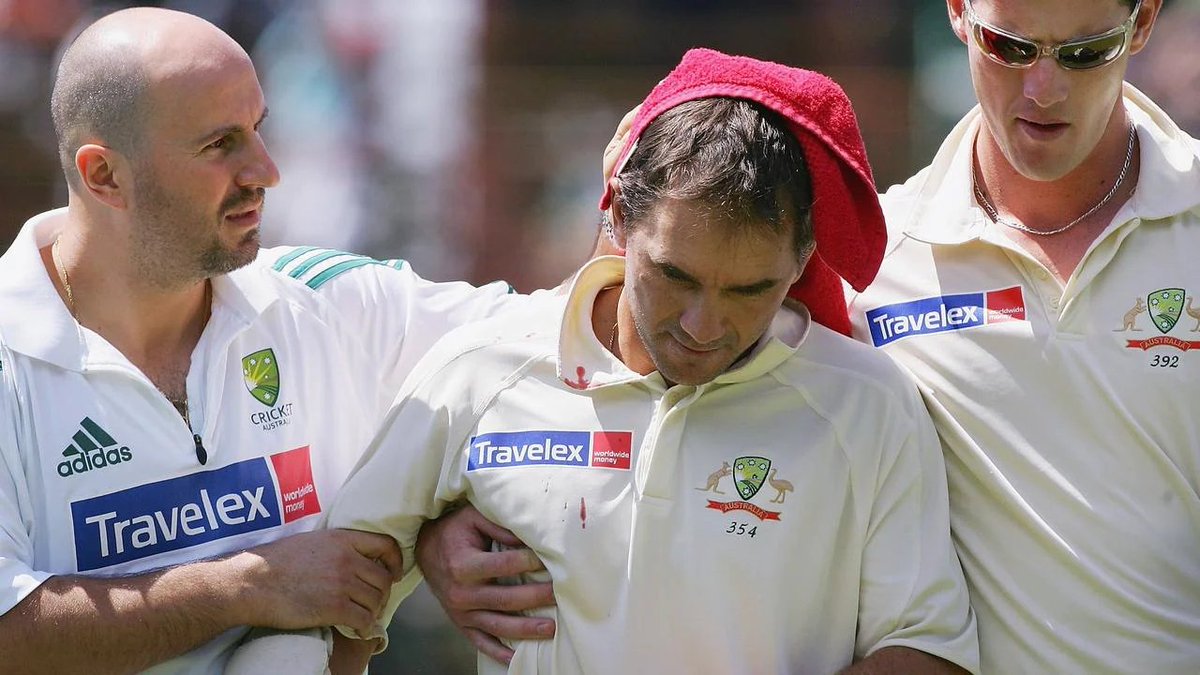THREAD
Story of how Shaun Tait earned his Baggy Green
Justin Langer = Getting hit
Shaun Tait = Raw Pace
What happens when it’s Shaun Tait x Justin Langer? This story that I am going to tell. But before that a bit on the protagonists of the story.
+
Story of how Shaun Tait earned his Baggy Green
Justin Langer = Getting hit
Shaun Tait = Raw Pace
What happens when it’s Shaun Tait x Justin Langer? This story that I am going to tell. But before that a bit on the protagonists of the story.
+

Maybe it had to do with his fondness for Martial Arts (he obtained the rank of Shodan-H- 1st degree black belt in Zen Do Kai, a kind of kickboxing) or just plain bad luck, but somehow Justin Langer attracted the most vicious of deliveries from the most ferocious pacers.
+
+
It began right from his Test debut against West Indies when Ian Bishop welcomed him to the highest level with a blow on the helmet with the first ball the 22-year-old faced. It continued till the end of his career where his appearance in his 100th Test was reduced to only one + 

ball on which Makhaya Ntini sent him walking back unsteady to the pavilion after hitting him behind the ear. In between, he also endured blows from Shoaib Akhtar at his peak in 1999 and Jermaine Lawson, who according to Langer, bowled one of the fastest spells he faced in 2003.
+
+

Now, let’s turn our attention to the second protagonist which is Shaun Tait. The pacer whose bowling speeds and attitude got many people to compare him to Jeff Thomson wasn’t nicknamed ‘The Wild Thing’ for nothing. He possessed and pretty much always unleashed pace with which
+
+

he could hurt anyone real bad. It’s a testament to his need for speed that he’s among the very few to have broken the 100mph mark in cricket.
Now, let’s come to the story. It’s one from Ashes 2005 but given the number of stories that are associated with this historic series,
+
Now, let’s come to the story. It’s one from Ashes 2005 but given the number of stories that are associated with this historic series,
+
it’s not often talked about.
Ahead of the fourth Test, the series stood evenly poised at 1-1. After losing the 2nd Test and just managing to save the 3rd, Australia realised that they desperately needed a third bowler behind McGrath and Lee as Gillespie was out of form and
+
Ahead of the fourth Test, the series stood evenly poised at 1-1. After losing the 2nd Test and just managing to save the 3rd, Australia realised that they desperately needed a third bowler behind McGrath and Lee as Gillespie was out of form and
+

Kasprowicz also wasn’t at his best. 22-year-old Tait had staked his claim for a place in the side by bowling a good spell in the tour game against Northamptonshire in which he forced opener Tim Roberts to retire with a blow to his head which left a part of the pitch red.
+
+

On 23rd August, two days before the fourth Test began, selector Trevor Hohns was in the nets and wanted to see if Tait had it in him to wear the Baggy Green that too in a crucial Ashes contest. Facing Tait on that day in the nets was unfortunately our man
+
+
Justin ‘come hit me’ Langer. Sensing that a Test debut was around the corner if he passed this Test, the young, wild and raw Tait just let it rip.
He bowled an inswinging yorker first up which cleaned up Langer’s off stump. A veteran of more than 90 Tests at that point, Langer
+
He bowled an inswinging yorker first up which cleaned up Langer’s off stump. A veteran of more than 90 Tests at that point, Langer
+

had no answer to even the next thunderbolt that Tait delivered. This time, it was the middle stump that had been blown away. Luckily, for him, the next ball didn’t hit the wickets as that would have really reflected poorly on the experienced campaigner. Where it hit, however,
+
+
isn’t something Langer remembers fondly. The third ball crashed into his unmentionables and the box was split into two as a result. Tait wasn’t done terrorizing Langer yet. He followed it up with a short ball that hit Langer on the elbow and brought him to his knees. A battered
+
+

and bruised Langer later wrote about the incident, “My confidence had been shattered, my elbow bruised and my voice was a little higher than usual.”
Hohns didn’t need more. And definitely, Langer didn’t either. Those four balls were good enough to secure a place for Tait in
+
Hohns didn’t need more. And definitely, Langer didn’t either. Those four balls were good enough to secure a place for Tait in
+
the XI that took on England in the 4th Test. He went on to take 3 wickets in the first innings and his debut wicket of Trescothick with a combination of pace and swing was as good a ball as any bowled in that series.
What a way to win yourself a Baggy Green!
What a way to win yourself a Baggy Green!

• • •
Missing some Tweet in this thread? You can try to
force a refresh









